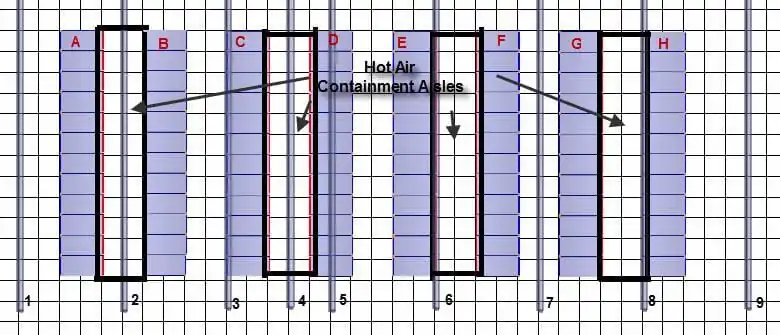Identifying the Best Conditions for Hot Air Containment13 min read

Before we explore what kind of round hole into which we should prefer hammering our square peg data center, I just want to remind my esteemed readers of the recent previous discussion on best conditions for data center cold air containment. After all, there has been a payday and a spring break since then so this important point may have slipped off a few pedestals of primary punctilious pondering: research conducted by Intel and T-Systems in the 2020 data center test lab in the Euro-Industriepark in Munich, Germany and reported on in the paper, “Data Center 2020: Containment Efficiencies Reveal No Significant Differences,” clearly demonstrated that neither hot aisle containment nor cold aisle containment delivered superior efficiency performance over the other. In addition, in that earlier blog piece, I floated the proposition that we might want to push the evolution of our terminology from aisle containment to cold air containment or hot air containment and cited some precedence from the industry as well as from the popular vernacular. Therefore, we have this piece’s title: Identifying the Best Conditions for Hot Air Containment.
Data center hot air containment includes the subcategories of hot aisle containment, cabinet containment with chimneys (“hot air collars” for conversations with fire marshals or building inspectors) and cabinet containment with integral heat exchangers. These different implementations all contain the hot exhaust air from ICT equipment and keep it isolated from the rest of the data center, but they do include some differences which bear on the decision process over which solution might be best for a particular set of existing or design conditions.
The absence of a raised access floor is not a prerequisite for hot air containment, but hot air containment is the best airflow management solution for a space without a raised floor. With no containment, it is necessary to deliver supply air to each cabinet. While that can be accomplished by overhead ducts and registers in front of each cabinet, it is most effectively accomplished with a raised floor and perforated floor tiles in front of each cabinet. With cold air containment, supply air needs to be delivered into each contained aisle. With hot air containment, on the other hand, supply air can be delivered to the room anywhere and, as long as some level of positive pressure is maintained, everything in that room will be adequately supplied. This condition could be particularly relevant for a project converting some other-purposed space such as a warehouse or factory into data center space or even for a new space design where raised floor cost-avoidance would be desirable. In fact, even where a raised floor is present, if it’s a legacy space with a 12” raised floor, hot air containment may still be the most practical solution. With today’s rack-level densities, raised floor heights along the lines of 36” or higher are going to be minimum requirements, so a 12” floor could be treated as a slab. Even better, such a low raised floor could provide the space for plumbing rear door heat exchangers for one of the variations of cabinet-level hot air containment.
“Hot air containment is the best airflow management solution for a space without a raised floor.”
Because hot air containment solves the problem of not having a raised access floor by allowing cooling air to be supplied into the data center room from any direction and from as few as a single source point, it means hot air containment is going to typically provide the most compatible airflow management solution with free air cooling, whether that’s a straight air-side economizer, air-to-air heat exchanger such as the re-purposed energy recovery wheel, evaporative cooling or indirect evaporative cooling. Because these economizer solutions are either introducing outside air or exploiting outside air temperatures in heat exchangers, cooling sources are typically on a roof or on a pad adjacent to a data center outside wall. In addition, these mechanical systems can remove upwards to and even exceeding a megawatt of heat load per unit, moving in excess of 100,000 CFM airflow. With these large volumes of airflow, it is convenient to minimize duct pressure head loss with fan walls or large overhead openings. These single or minimal supply air paths are highly effective in conjunction with hot air containment.
A space with a suspended ceiling or a high ceiling that would allow for installation of a suspended ceiling with a large cavity between the suspended ceiling and the true ceiling are ideal environments for hot air containment. Remember, if we can avoid the raised floor, then in a typical 16’ slab-to-slab clearance, we can get a 6’ cavity above our suspended ceiling, providing a more than adequate space for capturing and routing return air without having to engineer and install a return air duct system. Chimney cabinet containment and hot aisle containment will effectively exploit the potential of spaces with suspended ceilings by using the space above the ceiling for routing return air or evacuating waste air and thereby maintaining the hot air containment. Furthermore, in spaces with low slab-to-slab clearance or other inhibitors to useful space above a suspended ceiling, hot air containment can still be accomplished with cabinet-integral heat exchangers, such as rear door heat exchangers or under floor captive heat exchangers, since these cabinets are evacuating supply air.
Fire suppression is another important consideration for hot air containment. While NFPA 75 and NFPA 76 define cold air containment as a separate volume, thereby requiring a complete fire suppression system in addition to the system for the larger overall room, there is no such distinction for hot air containment. Most straightforward is the cabinet hot air containment with integral heat exchangers which can be assimilated into a space with any design of pre-installed fire suppression. If fire suppression is already installed and it’s on 8’ centers, then cabinet containment with chimneys or aisle containment is a perfect fit; with a 16’ pitch from cold aisle center to cold aisle center, the 8’ spacing of fire suppression will align nicely in the center of each hot aisle and cold aisle. If fire suppression is already installed on 10’ centers, some planning will be required with bar napkins or a CAD tool. Figure 1 below illustrates an example of this process.

Figure 1: Hot Aisle Containment with Pre-Action Suppression Pipes on 10’ Centers
Pre-action suppression pipes 1, 2, 3, 5, 6, 7, 8 and 9 in the example are pre-installed on 10’ centers and this layout shows how the containment aisles could be incorporated around them. One additional run (pipe 4) would need to be added inside the barriers between rows C and D. In addition, pipes 6 and 8 would need to be equipped with armovers or swing joints to achieve required sprinkler head clearance from containment walls. Note that most jurisdictions will require new heads for relocated sprinklers and then a new hydrostatic test for the completed revision. The key takeaway for this element is that a little planning will allow maximum utilization of installed fire suppression and minimal moves and additions.
Finally, if the space will be installed with network or storage equipment that cannot be incorporated in the containment without seriously violating the integrity of the containment because of non-standard airflow directions, those racks can be located outside of the containment rows, whether that is aisle containment or cabinet containment, and live in the ambient space which is essentially a macro cold aisle. This equipment will contaminate the data center supply air and likely require a slight reduction in supply temperature and therefore a reduction in overall efficiency, but will not directly contaminate the rest of the ICT equipment to the degree of creating hot spots or initiating alarms. From my previous blogs on this subject, my faithful readers will remember that I will always insist that there is no excuse for not finding a way to standardize the airflow of all equipment, regardless of the OEM design, but for all those stubborn non-believers, that uncontrolled equipment can live in a room with hot air containment while it obviously cannot in a cold air containment room.
Hot air containment and cold air containment both provide access to significant mechanical efficiencies in data centers. Hot air containment will always merit a first look for spaces where there is not a raised floor or the raised floor provides an inadequate volume for planned density or where a plan is being considered that excludes a raised floor. Hot air containment will usually optimize the effectiveness of any kind of direct or indirect air free cooling design. Spaces with suspended ceilings or standard slab-to-slab clearances of 16’ are ideal for hot aisle or cabinet chimney containment while lower clearances or low raised floor clearances are suitable for cabinet containment with integral heat exchangers. Hot air containment offers more options for minimizing challenges with fire suppression and is more forgiving of equipment with non-compliant airflow directions.

Ian Seaton
Data Center Consultant
Let’s keep in touch!
Airflow Management Awareness Month
Free Informative webinars every Tuesday in June.
0 Comments